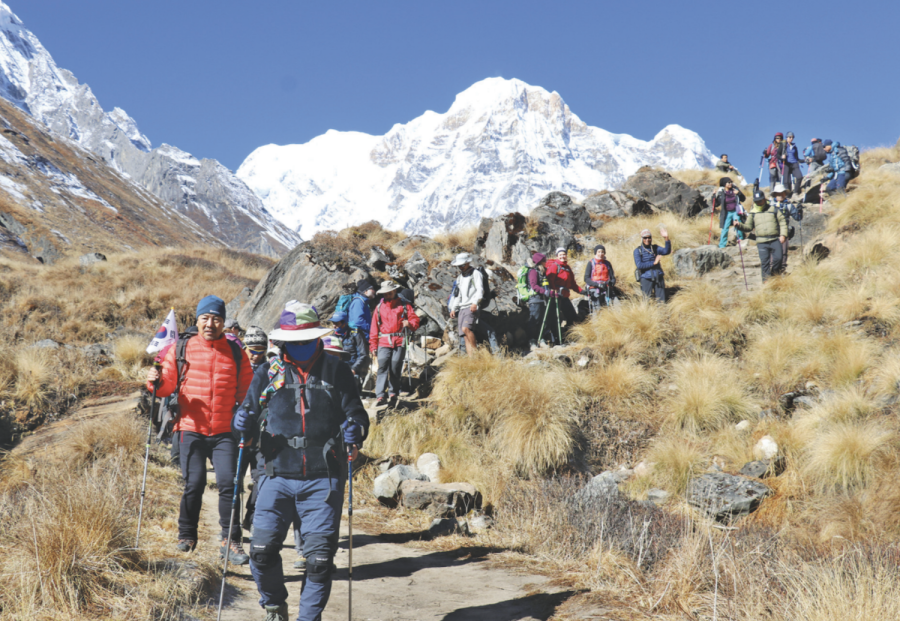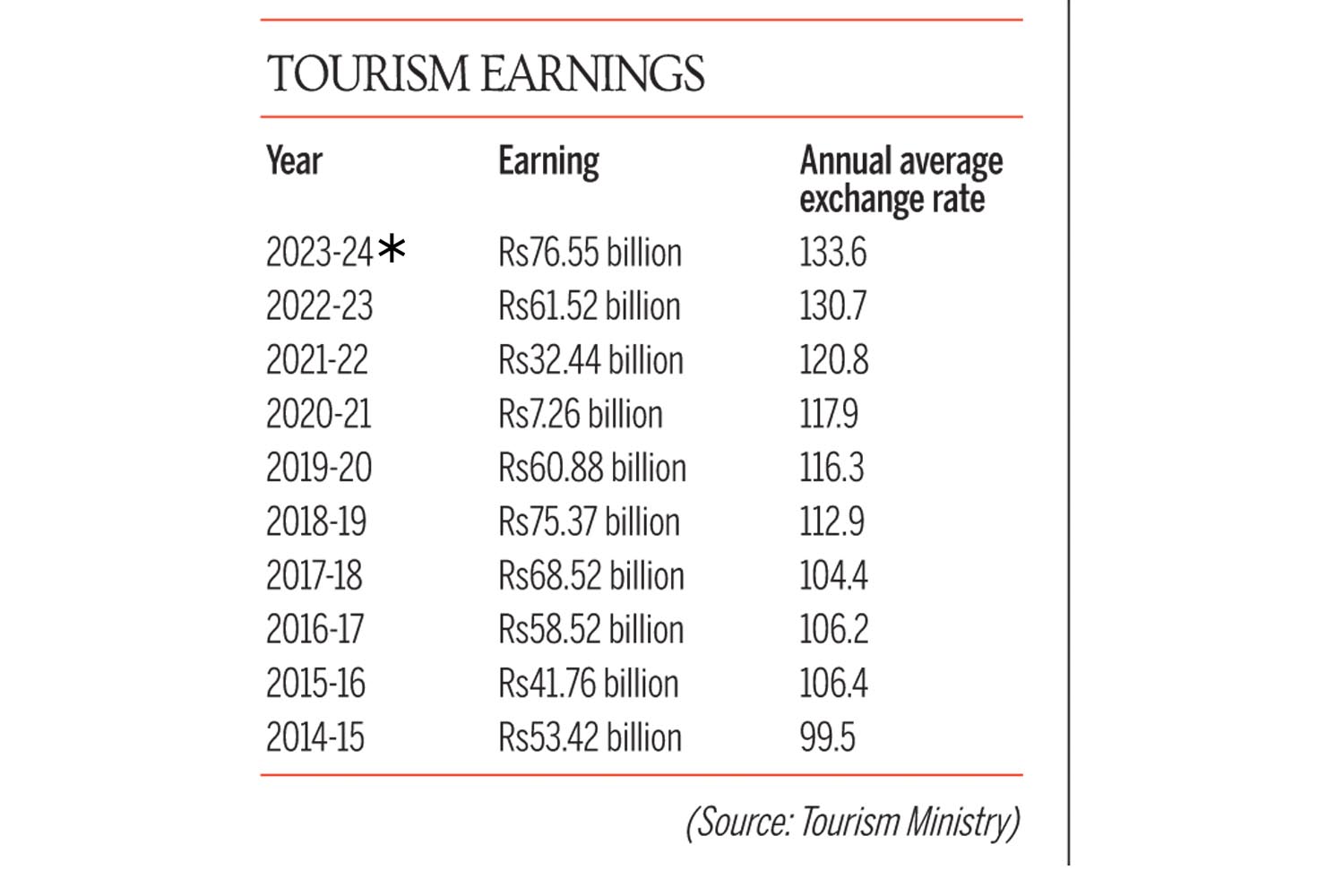Money
Tourism earnings hit record high
Nepal earned Rs76.55 billion from tourism in the first 11 months of the current fiscal year.
Sangam Prasain
Nepal recorded its historic high income from tourism in the first 11 months of the current fiscal year, which ended mid-June, according to the latest data issued by Nepal Rastra Bank. Industry insiders attribute this to the appreciation of the US dollar.
The central bank said that the country earned Rs76.55 billion from tourism in the review period, surpassing the record set in 2018-19 when the country had earned Rs75.37 billion from 1.2 million foreign tourists. (At that time, the exchange rate was $1=Rs112.9.)
According to a central bank report, Nepal received 1.06 million tourists in the first 11 months.
“The surge in tourism income is primarily a result of the exchange rate,” said Deepak Raj Joshi, former CEO of Nepal Tourism Board.
Any adjustments in the exchange rate will prompt an appreciation or depreciation of the tourist’s currency, affecting transport costs and the tourist’s decisions to visit the country.
“Thus, the exchange rate impacts the number of tourist visits and tourism receipts,” said Joshi.
“Besides, the growth of international chain hotels and Nepal gradually switching to a digital payment system has also contributed to the growth in tourism income.”
The tourism ministry’s statistics show that the average stay of tourists in Nepal is currently 13.2 days, while they spend $41 per day.
Gunakar Bhatta, spokesperson for the Nepal Rastra Bank, said the depreciated exchange rate positively relates to the tourism demand, as travel becomes less expensive when visiting a devalued country.
“The currency factor, normally, forces tourists to select a destination before a trip. In this context, a country with a depreciation in domestic currency will attract international tourists,” said Bhatta.
He said that while most of Nepal’s economic indicators have been underperforming, tourism has been doing exceptionally well.
While Nepal’s economy is anticipated to grow by 3.87 percent in the current fiscal year, accommodation and food service, which are linked to tourism activities, are expected to see a robust growth of 21.84 percent, the highest among all 18 economic compositions in the Nepali economy.
“This shows how the tourism industry has been a boon for Nepal’s sluggish economic growth.”
The digital payment system has also been making tourism income transparent.
Paras Kunwar, chief operating officer of Fonepay, said Indian tourists have been spending Rs5 million a day since Nepal started the payment system through the quick response (QR) code on March 1.
“Since the central bank has fully opened the digital retail payment gateway for Nepali operators with any other country, it will help bring more foreign currencies.”
Through the budget, the government has announced that it will draw 1.6 million foreign visitors this year.
According to industry insiders, the target is attainable, but there are a few challenges.
From November 8, Kathmandu’s Tribhuvan International Airport will be closed for 10 hours daily, from 10 pm to 8 am, for five months until March 31, to expand the taxiways.
September-November is Nepal’s peak tourist season.
Besides, industry insiders say the Nepal Tourism Board has been headless for the past four months, affecting all international promotional and marketing events.
A number of reports, including the latest by the International Monetary Fund (IMF), said Nepal’s economic activity is expected to pick up, with growth reaching 4.9 percent in the next fiscal year 2024-25. This growth will be supported by an increase in tourist arrivals, boosting domestic demand.
According to the Nepal Tourism Board, the country’s tourism promotional body, in 2023, tourist arrivals crossed the million mark for the first time in four years.
Foreign arrivals had crossed the one million mark for the first time in 2018 when the country received 1.17 million foreign visitors.
The number reached 1.19 million in 2019. Then, the Covid pandemic started in early 2020, bringing arrivals to a standstill. Travel restrictions and an economic slowdown triggered by lockdowns delivered a massive blow to Nepal’s burgeoning tourism industry, decimating revenues and profits after 2020.
Nepal received 230,085 and 150,962 tourists in 2020 and 2021, respectively. In 2022, the number shot up to 614,869.
Joshi said that by the end of 2024, Nepal may get 1.2 million tourists in the year.
“A careful execution of plan and proper marketing, especially in China, could boost arrivals to 1.6 million,” said Joshi. “It will be justified to shift Kathmandu’s airport expansion from November to December, to let the peak season pass.”
Dozens of luxury hotels have opened across the country so there are no problems with accommodation, he said.
Nepal has been widening roads and building other infrastructure, like airports, which will help attract more tourists.
However, industry insiders say the government’s neglect of air safety problems could hinder future growth, particularly in the high-end segment, where travellers consider the safety of any destination country while making travel plans.
Most embassies have put Nepal’s air safety situation on their travel advisories. The European Commission imposed this list in 2013 after Nepali airlines failed to meet international safety standards.
The government has wilfully ignored the call of the United Nations aviation watchdog, the International Civil Aviation Organisation, to split Nepal’s civil aviation body into two entities: service provider and regulator.
The separation is a crucial organisational reform agenda which has been a work in progress for the past one and a half decades.





 9.12°C Kathmandu
9.12°C Kathmandu














